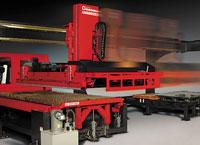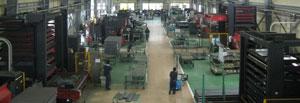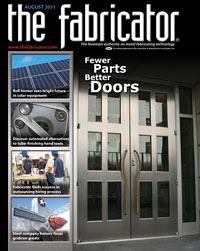Product Manager, CNC Division
- FMA
- The Fabricator
- FABTECH
- Canadian Metalworking
Categories
- Additive Manufacturing
- Aluminum Welding
- Arc Welding
- Assembly and Joining
- Automation and Robotics
- Bending and Forming
- Consumables
- Cutting and Weld Prep
- Electric Vehicles
- En Español
- Finishing
- Hydroforming
- Laser Cutting
- Laser Welding
- Machining
- Manufacturing Software
- Materials Handling
- Metals/Materials
- Oxyfuel Cutting
- Plasma Cutting
- Power Tools
- Punching and Other Holemaking
- Roll Forming
- Safety
- Sawing
- Shearing
- Shop Management
- Testing and Measuring
- Tube and Pipe Fabrication
- Tube and Pipe Production
- Waterjet Cutting
Industry Directory
Webcasts
Podcasts
FAB 40
Advertise
Subscribe
Account Login
Search
Seeing the (green) light
Sheet metal cutting automation increases uptime
- By David J. Stone
- August 1, 2011
- Article
- Laser Cutting
Most fabricators have adjusted their manufacturing processes significantly to compete. These days many customers place small orders (sometimes just one piece), require short lead-times (often just hours), and demand low prices. An operator running a punching or laser cutting system may look extraordinarily busy “running” the machine. But running the machine is not the same as producing good parts ready for downstream forming, joining, and assembly.
In this environment, you must ensure that these machines aren’t just “running” but actually producing the required parts at peak efficiency.
Green-light-on time refers to the percentage of time a machine is actually producing parts in relation to the overall time the system is powered up and ready for production. The industry green-light-on average for a nonautomated CNC punch press is between 35 and 45 percent, while a nonautomated laser may come in between 40 and 65 percent. On a nonautomated system, in fact, 50 percent green-light-on time is very respectable.
That’s a shock for many, because plant managers see their operators working hard all day around the machine. Those operators are truly busy, of course, but it’s often because they are getting the machine ready for production. In reality the work center isn’t actually producing to its full potential. The good news is there is almost always room for improvement.
More Isn’t Always Better
One way to produce more parts, of course, is to buy another machine, and in fact this is usually the first—and sometimes only—option considered. While adding a second manual machine theoretically doubles daily production, it also adds costs: machine payments; another machine operator; floor space (which may not even be available); and ongoing operating costs such as electricity, processing gases, maintenance, and tooling. Just adding another stand-alone machine also means the green-light-on time will remain the same.
With nonautomated machines, productivity hinges on the operator’s ability to be at the machine to input jobs, load sheets of raw material, and remove finished parts and skeletons. In a manual situation, the constraint isn’t how fast new machines can cut; it’s how fast operators can work. Operators may look busy programming and moving material, but all this work may not significantly increase the speed at which parts are produced. A more powerful laser or modern punch press may cut metal faster, but sheets still must be loaded, and parts still must be unloaded. If the speed of material loading and unloading isn’t increased, a cutting center’s green-light-on time will remain between 35 and 65 percent.
Ironically, as new machines continue to achieve faster processing times, it becomes more difficult to achieve maximum productivity if operators must move metal in and out of the workspace manually. Many times these machines process metal so quickly, operators simply can’t keep up.
Automation Retrofit
Many shops attempting to improve green-light-on time choose to retrofit automation to existing equipment. By adding the right type of automation to a machine, along with proper operator training, a fabricator can improve green-light-on time significantly, often to between 80 and 90 percent. This effectively doubles the productivity of a stand-alone machine and in many cases eliminates the need for a second machine altogether. The increase comes from the operation not being dependent on an operator loading and unloading material. For increased throughput, machines can be added to existing automation, creating a multiple-machine cell.
The automation loads a sheet of raw material, removes processed parts (if so equipped), unloads the skeleton, and starts cutting the next nest of parts or job in the schedule. Efficiency depends less on operator intervention. Automation takes the same amount of time to load and unload material, every time. It never gets tired or takes breaks. In other words, it adds significant predictability to the primary cutting process. If scheduled with enough jobs, the automated machine can process parts essentially unattended until the storage device runs out of sheets.
System Options
Automation systems can vary from the most basic to very sophisticated multishelf material storage and retrieval systems with automatic part unloading. A simple system can be as basic as a sheet load/unload device with two carts or pallets, one each for raw material and finished parts. Whether installed as a retrofit on existing equipment or as part of a new machine, the system works well for small shops that need to increase productivity while maintaining a budget, staying within floor space requirements, and not being required to hire more employees or devote more of their existing labor to the system.

Figure 2: How parts flow out of the primary cutting process is vital to any automated setup. Offload tables (shown at right) should be placed close to downstream processes to minimize work-in-process travel distance.
The step up from this includes many middle-range options, such as multiple load and unload carts and towers with from five to 20 shelves holding up to 6,600 pounds of material up to 1 inch thick per shelf. More elaborate systems can have multiple towers or bays of up to 200 shelves that can store material (full-size sheets and remnants) and blanked parts while keeping track of inventory. They access specified raw material from a shelf, deliver it to multiple blanking machines (lasers, CNC punch presses, or combination punch/lasers), and return processed parts back to a specified location until they are ready to go on to the next process, such as bending, welding, deburring, powder coating, or assembly.
This type of system can help automate an entire shop, streamline the fabrication process, and track parts and inventory. OEMs often find such systems to be beneficial, especially if they want to attain fully unattended operation.
Systems may include servo-controlled part-removal devices that use suction cups or magnets to remove finished parts (usually 0.25 in. or thinner) as they are freed from the skeleton (see Figure 1). The parts then can be stacked on pallets or conveyors for secondary processing. Not only does this eliminate manual handling, it also helps keep parts organized and as scratch-free as possible, further reducing costs.
Planning for the Future
Viewing CAD models of potential layouts helps shops predict how everything will fit together on the floor and plan for optimal work flow required after the blanking process. Flexibility in design should be a key consideration for anybody planning to automate the blanking process. The more sophisticated the system, the more likely a number of modifications will need to be made to the equipment to suit production, floor space, ceiling height, and budget requirements.
Lack of flexibility or customization can be a real problem sometimes because the automation may not provide good flow to the rest of the fabrication processes. For instance, many shops place automated systems near the loading dock to minimize distance between the delivery truck and the material towers. But shop managers should consider how parts flow out of the primary cutting process as well (see Figure 2).
Consider a situation where most blanked parts flow downstream to bending, some go directly to welding, and a few are sent out immediately for plating or painting. In this case, it may make sense to place part-offload tables close to the bending area to minimize travel distance for work-in-process. But what if the bending department is far from the loading dock? Would it be worth it to move certain press brakes closer to ease part flow, or place the automated blanking system closer to the bending area but farther from the loading dock? All this depends on work flow, which can be quite complex in a high-mix environment.
This is where careful planning, customization, and virtual modeling of shop operations come into play. Customizing the automation to fit existing work flow can make the decision to add automation much easier, because rearranging everything else on the floor around automation can be both time-consuming and costly.
It’s just as important to plan for future expansion. Being able to add on to the automation (more shelves or load/unload carts or a part-removal device, for example) or to add more machines to the automation can be very important when deciding on where to install the automation. Modular automation allows shops to adapt to changing needs as they grow and expand capacity.
Cultural Effects
Extending a machine’s green-light-on time to nearly 90 percent and reducing manual material handling help meet shorter lead-times now demanded by almost all customers. With offline programming and scheduling, a machine operator running an automated blanking system can focus on ensuring that material storage shelves are filled and offloaded when needed, make the occasional laser nozzle change, do tooling setups for a punching machine, and perform other basic functions as required. Some shops may establish a small cell near the machine so that a cross-trained operator can perform bending, welding, or even assembly as the blanking machine cuts parts.
That same operator also isn’t hurting his back anymore by moving significant amounts of material. The Bureau of Labor Statistics has reported that more than 36 percent of injuries involving missed workdays were the result of shoulder and back injuries. Lifting, pushing, and pulling sheet metal off shelves and onto cutting machines probably isn’t anyone’s career aspiration. Eliminating such manual handling can have significant ergonomic-, insurance-, and morale-related benefits.
Good Change
Whatever the type of automation—simple, complex, or somewhere in between—managers and operators must take the necessary steps for proper implementation, which includes training. Operators often will need to be reassured that adding automation doesn’t mean they will be replaced by it. New equipment requires operator training, and employees must have an open mind, approach change positively, and continually re-evaluate existing processes.
In other words, everybody must buy in to the fact that change will be required. Great strides have been made in simplifying the transition to automation. When fabricators implement automation correctly, many find they wish they had made the switch much earlier.
About the Author
David J. Stone
7025 Firestone Blvd.
Buena Park, CA 90621
714-739-2111
Related Companies
subscribe now

The Fabricator is North America's leading magazine for the metal forming and fabricating industry. The magazine delivers the news, technical articles, and case histories that enable fabricators to do their jobs more efficiently. The Fabricator has served the industry since 1970.
start your free subscription- Stay connected from anywhere

Easily access valuable industry resources now with full access to the digital edition of The Fabricator.

Easily access valuable industry resources now with full access to the digital edition of The Welder.

Easily access valuable industry resources now with full access to the digital edition of The Tube and Pipe Journal.
- Podcasting
- Podcast:
- The Fabricator Podcast
- Published:
- 04/16/2024
- Running Time:
- 63:29
In this episode of The Fabricator Podcast, Caleb Chamberlain, co-founder and CEO of OSH Cut, discusses his company’s...
- Industry Events
16th Annual Safety Conference
- April 30 - May 1, 2024
- Elgin,
Pipe and Tube Conference
- May 21 - 22, 2024
- Omaha, NE
World-Class Roll Forming Workshop
- June 5 - 6, 2024
- Louisville, KY
Advanced Laser Application Workshop
- June 25 - 27, 2024
- Novi, MI
































